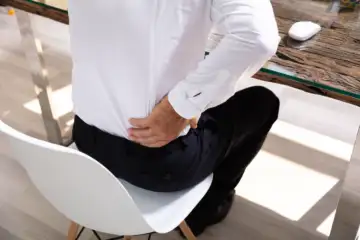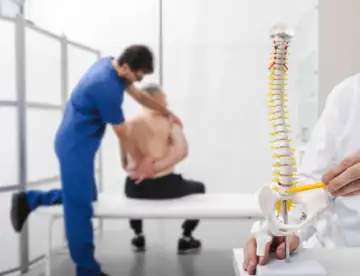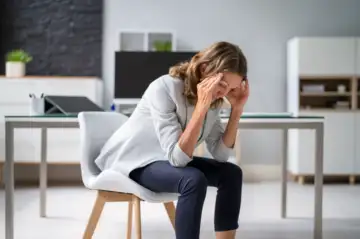Back pain often begins as a minor discomfort but can gradually become more troublesome over time, and a new study suggests that a form of talking therapy might be able to help.
Published in The Lancet Rheumatology, the study explored the impact of cognitive functional therapy (CFT) – a type of psychotherapy to “address the causal mechanisms” of chronic lower back pain and help to change the way people think about and respond to pain.
Researchers recruited more than 1,000 participants for this study and divided them into three groups: one received standard treatment, another underwent CFT, and the third received CFT along with biofeedback, which tries to teach a person to control automatic body functions.
The results showed that both CFT on its own and CFT combined with biofeedback were significantly more effective than standard care in reducing activity limitation caused by lower back pain.
But what actually causes back pain? Here are some of the most common causes…
1. Muscle strains and ligament sprains
 A common cause of back pain is an injury, like a pulled muscle.
A common cause of back pain is an injury, like a pulled muscle.
“The first episode of back pain is usually related to a sudden injury, ” says Sam Bhide, advanced practice physiotherapist, and founder and clinical director at Physiozen Ltd. “Sudden movement can cause injury and bring on back pain after you return to the gym after time off, for example, because your body has forgotten what to do.”
Muscle strains and ligament sprains are typically diagnosed through physical examinations which are usually conducted by physiotherapists or doctors.
“These physical examinations usually include movement, muscle and ligament tests,” says Mick Thacker, qualified physiotherapist, professor of pain at the Royal College of Surgeons in Ireland, and head of research and design EQL.ai. “In the majority of cases, that’s actually enough to indicate potentially the best way to manage people’s pain.
“This could include a variety of techniques, but usually the key aspect of managing back pain is to encourage people to stay active and do exercise which is respectful of their pain.”
2. Osteoarthritis
“Osteoarthritis affects hyaline cartilage joints. The facet joints in your spine have hyaline cartilage, and therefore are prone to osteoarthritis,” explains Thacker.
The age-related changes in the spine associated with spinal osteoarthritis is referred to as spondylosis.
“People with spondylosis generally experience a low-grade pain that follows a traditional pattern,” says Thacker. “They tend to be very stiff for about half an hour to an hour in the morning, then it generally eases off, and they enjoy a degree of pain-free movement until the middle of the afternoon, and then their pain generally gets worse into the evening.”
3. Osteoporosis
 Osteoporosis is not usually painful until a bone is broken, but broken bones in the spine are a common cause of long-term pain, according to the NHS website.
Osteoporosis is not usually painful until a bone is broken, but broken bones in the spine are a common cause of long-term pain, according to the NHS website.
“Osteoporosis can affect the spine and is caused by a dip in your bone mineral density,” says Thacker. “It’s often predominately seen in females, as the bone mineral density tends to drop around the menopause, and then the symptoms of osteoporosis come on about 10-15 years later, as the bone has become weaker over time.
“In terms of pain from osteoporosis, movement does benefit it, but you have to be careful. The bone is potentially fragile and weakened, so rhythmic, low intensity, but still load-bearing exercise is usually recommended.”
4. Bulging or ruptured discs
 “Discs are actually a very stable structure that don’t really present that often in the clinic. However, when they do, they are generally associated with two types of problems,” says Thacker.
“Discs are actually a very stable structure that don’t really present that often in the clinic. However, when they do, they are generally associated with two types of problems,” says Thacker.
The first issue is to do with inflammation.
“A ruptured disc can inflame the tissue around it, and you get a small immune inflammatory episode in the surrounding tissue because discs are actually not recognised by your immune system,” explains Thacker. “Inflammation associated with that can take several weeks to subside.”
The second problem is that large disc bulges can compress the nerves in the spine, potentially affecting bowel and bladder function.
“The problem with large disc bulges is that it can actually compress the nervous tissue of the spine, and that can be quite serious if it compresses what’s called your cauda equina, which is the nervous tissue at the bottom of your of spine, which can affect the nervous control to your bowel and bladder,” says Thacker.
“So, the disturbance of bowel and bladder function can be associated with back pain. That can be a medical emergency because if you don’t seek care for that quickly, it can be a long-standing problem and you can become incontinent.”
5. Psychological factors
 Some research suggests that there are specific risk factors associated with back pain, often referred to as ‘psychosocial yellow flags’.
Some research suggests that there are specific risk factors associated with back pain, often referred to as ‘psychosocial yellow flags’.
Thacker says that factors such as stress are known to be amplifiers of a pain, rather than the generators of it.
“They’re generally factors associated with people under pressure and stress at work, and under extreme workloads of work, who undergo a degree of change within the nervous system,” says Thacker. “For example, it affects people’s circulatory cortisol and stress system, and that makes people more prone to the onset of back pain.
“Also, if you’ve already got existing pain, factors like stress will always make that pain worse. So, unless you address those factors, people don’t tend to respond well to the treatments that are advocated.”
Bhide agrees and adds that combined physical and psychological treatments are particularly effective.
“In combined psychological and physical programs, people do exercises but also see a psychologist who gives their input and then talks about pain education and gives them a little bit more understanding of how to manage it better,” explains Bhide. “This tends to be the best approach for chronic or persistent pain.”
